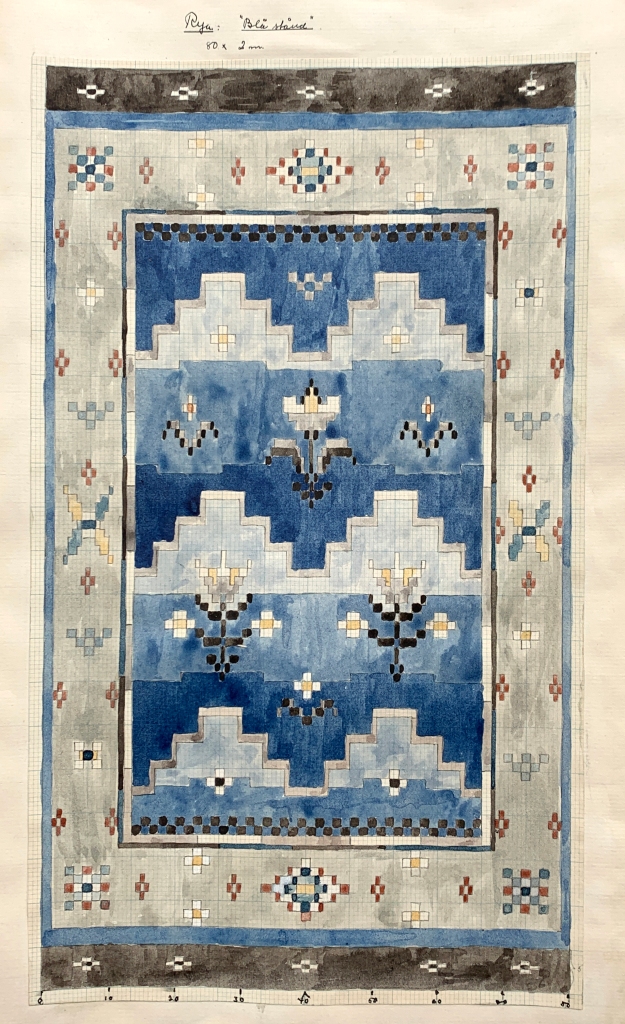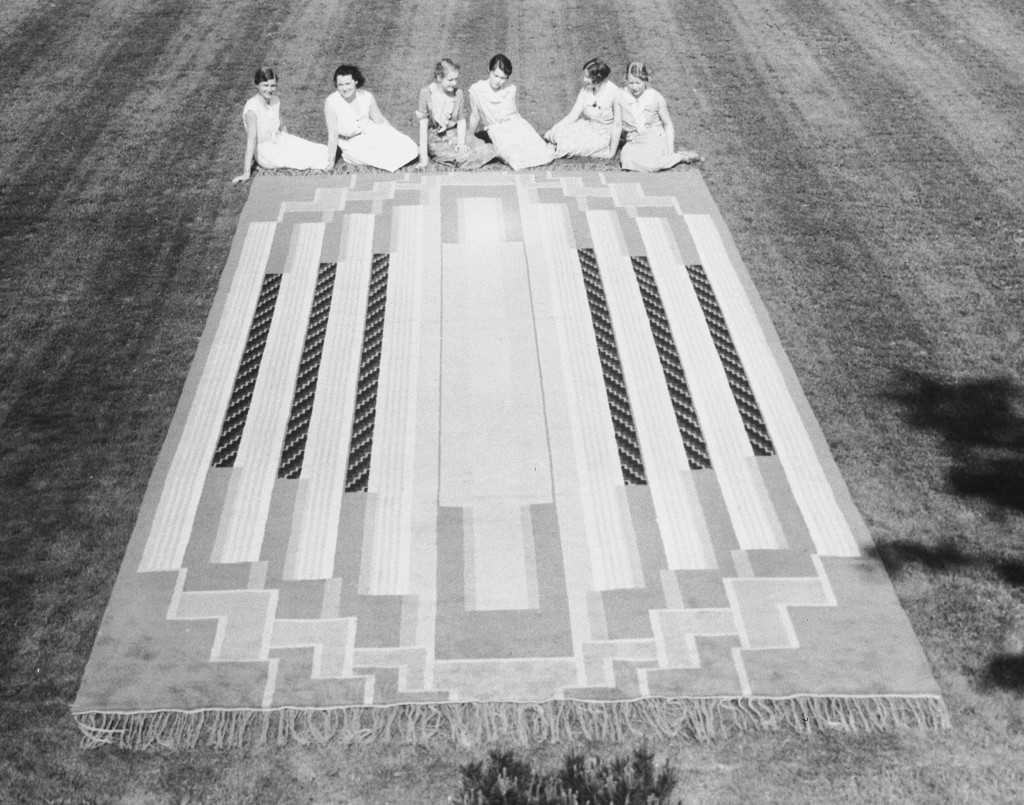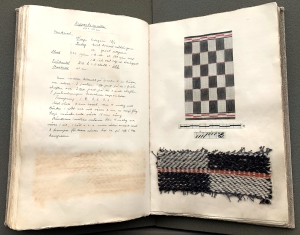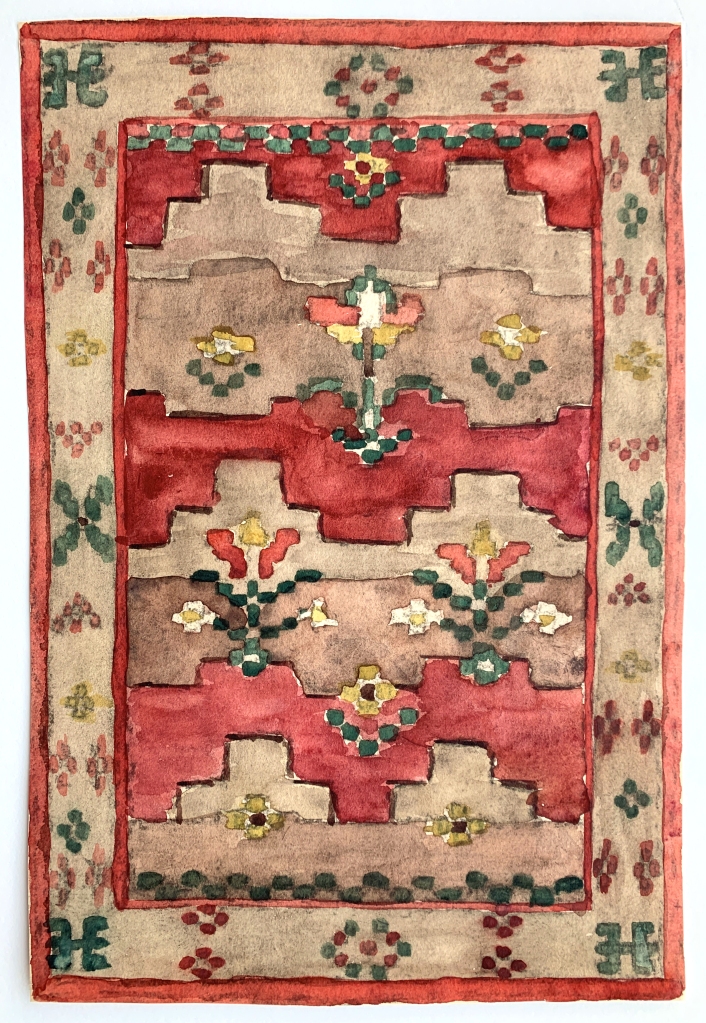Among the treasures in Cranbrook Archives is a manuscript that, although I can’t read anything written inside, is one of my favorite things at Cranbrook. Bound in handwoven cloth by the author herself, the cover hints at what’s inside. This is Ruth Ingvarsson’s weaving book.

One of two manuscripts written in Swedish and assembled by Ingvarsson between 1932 and 1935, each of the more than 100 pages discuss different weave structures, materials, patterns, and techniques. Who was Ingvarsson, and how did these treasures end up at Cranbrook?
Rut “Ruth” Elisabeth Ingvarsson was born on October 1, 1897 in Glemminge, Skäne, Sweden. Like many Scandinavian girls, she learned weaving first from her mother and then at school, graduating from the Glemminge Folkskola in 1918. In 1922, Ingvarsson began studies at the celebrated weaving studio of Märta Måås-Fjetterström in Båstad, Sweden.
Ingvarsson continued working for Måås-Fjetterström until 1928, learning technical skills including knotted pile rya or flossa weaves, rölakan flatweave, and a discontinuous (or supplemental) weft style of tapestry weaving known as the MMF technique. Under Måås-Fjetterström, Ingvarsson developed great skill painting watercolor sketches on graph paper in the popular “Swedish Grace” (or “Swedish Modern”) style. She also befriended another young weaver, Lillian Holm, who entered into the Måås-Fjetterström studio in 1926.

In late 1929, Ruth Ingvarsson and Lillian Holm immigrated to America to start work that December at Studio Loja Saarinen, Cranbrook’s weaving workshop. Here, Ingvarsson executed designs from Loja herself and other members of the Saarinen family, as well as designs by the Studio’s shop supervisor and prominent Swedish weaving expert Maja Andersson Wirde.
Throughout 1930 and 1931, Ingvarsson and the other Swedish immigrant weavers spent hours at the looms making the many magnificent rugs for Kingswood School for Girls. It is highly likely that, with her training and skill in the MMF technique in which it was executed, Ingvarsson worked on the monumental Festival of the May Queen hanging for Kingswood’s Dining Hall.

In 1932, Ingvarsson and Holm returned to Sweden to study at the famed Handarbetets Vänner (Friends of Handicraft) in Stockholm. The school, where Maja Andersson Wirde had taught for decades before coming to Cranbrook, is where Ingvarsson began her untitled manuscript and produced another hand-bound manuscript, Vävteori.
Enrolled at the Handarbetets Vänner from January 9, 1932 to June 6, 1933, Vävteori (roughly, “Weaving Theory”) documents how to set up a loom, the tools used for weaving, and features many patterns, watercolor sketches, and actual woven samples. It is bound in a silk cover woven, presumably, by Ingvarsson.
Ruth Ingvarsson returned to Michigan and Studio Loja Saarinen in 1933. However, as the Depression caused Saarinen to scale back her operation, Ingvarsson spent much of her time teaching private weaving lessons in her own studio in Highland Park (1935-1937) and in Detroit (after 1937) while also completing commissions for the Studio throughout the decade.
For most of 1941, Ingvarsson worked alongside Holm weaving the last major project of Studio Loja Saarinen, the Sermon on the Mount hanging for First Christian Church in Columbus, Indiana. Ingvarsson was likely involved in some of the very last pieces from Studio Loja Saarinen: rugs for the new Cranbrook Art Museum, which opened the same year the Studio closed, in 1942.
During the summers of 1946, 1948, and 1951, Ingvarsson returned to Cranbrook to teach weaving at Kingswood. From 1949 to 1951, she taught at the Detroit Society of Arts and Crafts and from 1936 to 1938 and 1951 to 1969 she was a part-time weaving instructor at Wayne State University.
Ingvarsson continued to produce her own textiles and exhibited widely, showing at the Detroit Artists Market, the Detroit Institute of Arts, Michigan Artists Craftsman Shows, and the Boston Society of Arts and Crafts. She won numerous awards throughout the 1940s and 1950s, including first prize for an altar cloth in the national Exhibition of Contemporary and Religious Art in 1957. Ingvarsson was a member of the Michigan Weavers Guild.
Ruth Ingvarsson became a U.S. citizen in 1956, and died on September 15, 1969 in Highland Park, Michigan. Before she died, Ingvarsson left her manuscripts, sketchbooks, and other materials to Lee Morrell, who donated them to Cranbrook Archives in 1997. These two manuscripts provide invaluable insight into the training, design, and technique of Swedish weaving in the twentieth century.
If you want to learn more about Studio Loja Saarinen, join the Center next Tuesday, July 28, 2020 at 10:00am or 7:00pm EDT for our first Uncovering Cranbrook virtual lecture: Studio Loja Saarinen: The Art and Architecture of Weaving. I’ll be talking about the history of and designs from the Studio, and showcase many of the remarkable rugs and hangings produced here at Cranbrook by the skilled hands of weavers like Ruth Ingvarsson.
—Kevin Adkisson, Associate Curator, Cranbrook Center for Collections and Research






Wonderful article which led me to check my copy of the First Annual International Textile Exhibition in 1944 held at the Weatherspoon Gallery at the Woman’s College of North Carolina (UNC Greensboro). While Ingvarsson did not exhibit in the venue, several other Cranbrook people did including Lillian Holm, Edna Vogel, Marianne Strengell and Robert Sailors. Vogel and Strengell both won a 1st place award and Sailors took a second in the woven textiles category. Quite impressive in their domination. Unfortunately, I’m unable to check subsequent catalogs for Ms. Ingvarsson’s participation in later exhibitions.
LikeLiked by 1 person
Thank you for checking, Michael! Ingvarsson does not show up in Archives (or online) nearly as much as the Holm/Vogel/Strengell circuit. I’m not sure why. If you ever come across her name, please do let us know! Thanks! –Kevin
LikeLike
Lillian Holm taught weaving at Kingswood in the summers of 1944 and 1945, as well as during the school year, because I was there! Thank you for this beautiful article!
LikeLike
That’s fantastic! I wish I could time travel and join you! -Kevin
LikeLike
I heard that Ingvarsson left a bunch of weaving notebooks in the Kingswood weaving studio to be passed down to students and teachers.
LikeLike
I believe her last name is spelled Ingvarson, with one S not two.
LikeLike
Thank you, Elizabeth. Our research has found the two S spelling, including on her American citizenship record and her grave marker. Her American Social Security has only one S.
– Leslie M.
LikeLike
We did a little more digging, and she also signed her weaving book (shown in the blog) with two “s.”
P. S. If there are any relations of Ruth Ingvarsson’s reading this blog, we would love to get in touch! Email center@cranbrook.edu. Thanks, Kevin Adkisson
LikeLike
Interesting! I have two weavings of Ruth’s. One is signed with one “s”. The other is just her initials.
LikeLike